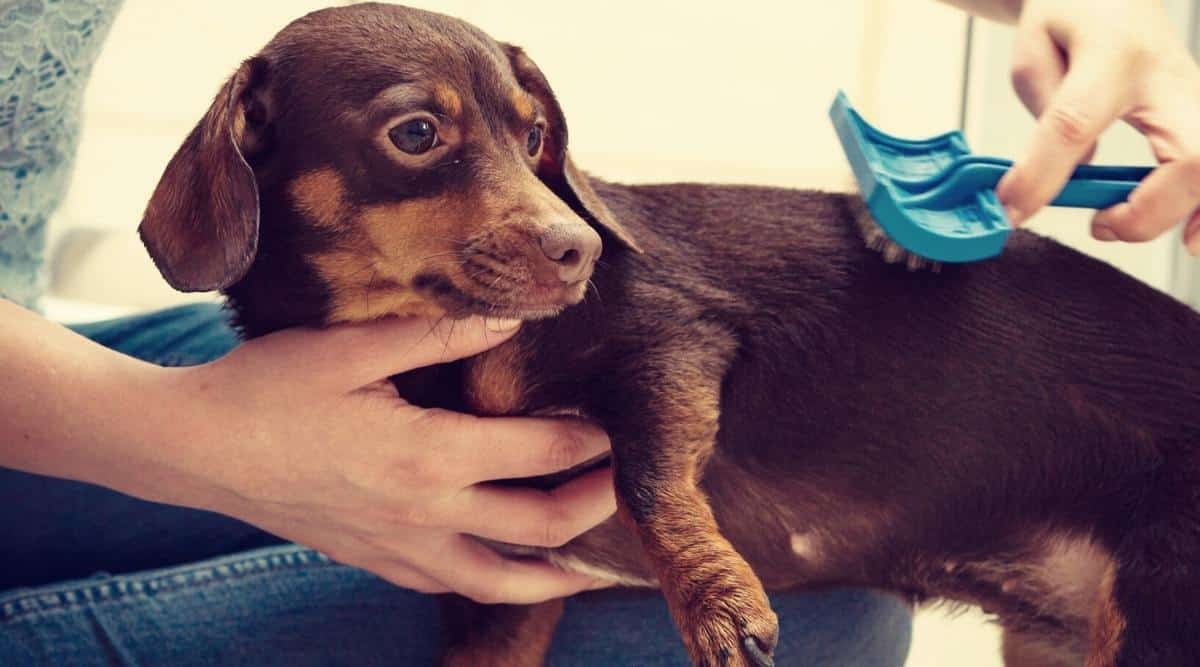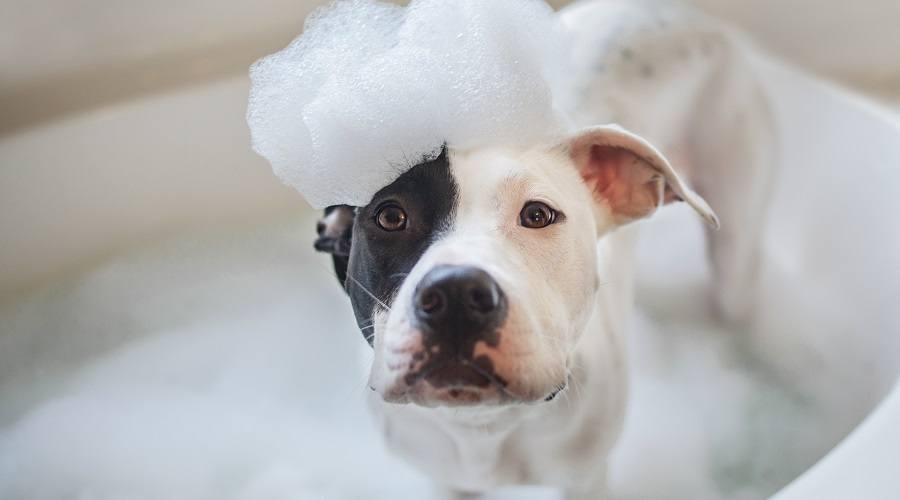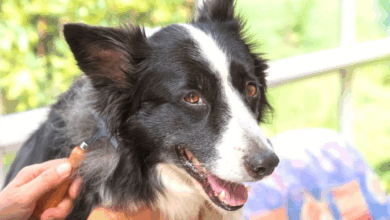German Shepherd Shedding: How Much Do German Shepherds Shed?
When you purchase through links on our site, we may earn a commission. Here’s how it works.
Thinking of adding a German Shepherd to your family, but need to know how much they shed before you do? Maybe you’ve recently adopted one and aren’t sure how to deal with their shedding? There are both short and long answers to these questions, and we will cover all of them. But the bottom line is that yes, German Shepherds Shed, and they shed a lot!
In this comprehensive guide, we explain why your German Shepherd sheds, and what to do if they are shedding more than normal. There’s also a few tricks of the trade to better manage excess hair around your home, which your canine companion is bound to leave behind.
So, if you’ve recently adopted a new German Shepherd puppy, or are considering the breed as a family pet, there’s some important information you’ll want to consider. The German Shepherd’s shedding habits shouldn’t be the reason to avoid this pup (their benefits outweigh the negatives) but there’s a few things you can do to make owning one a little bit easier. Let’s jump in!
Table of Contents
German Shepherd Coats
The German Shepherd’s black and tan coat is one of its most distinguishing features. There are few canines that exist today, that are as easily spotted as this breed. They are notorious for having thick, yet soft fur. Their coats can range in length, but they are usually of medium length and density, to longer, which makes them look more like a wolf. Their coats don’t vary by breed line, meaning both German Shepherds from American and European breed lines will shed just as much.
The German Shepherd has a double coat, which is why they have dog “fur” and not dog “hair.” Yes, there’s a difference between the two, with single coats usually referred to as “hair,” and double coats referred to as “fur.” Because they have a luxurious double coat, this means they will shed year-round, specifically more in the winter and the summer.
German Shepherd Coat Colors
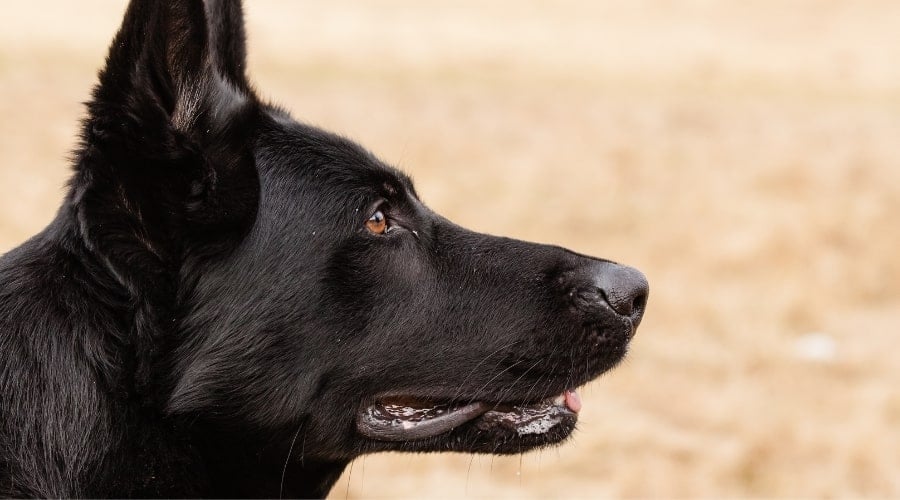
German Shepherds can have a variety of different coat colors. The most common coat color is black and tan, followed by black, and then sable. White German Shepherds have a controversial coat color, where some people argue it’s not even an actual member of the breed. They can also have blue coats, which are more accepted, but also rarer.
Regardless of their coat color, there is no difference in shedding frequency amongst the breed. What matters more is the length of their coat. Both Long Coats and Short Coats will shed the same amount, but longer or fluffier coats will definitely show more around your home due to the length of their coat. This is important to keep in mind when adopting a puppy. Look for a medium-length coat that’s less fluffy, and the fur will be less likely to show around your home.
Shedding Frequency
German Shepherds are well equipped to handle colder weather and can survive just fine in hotter climates. They have double-coats, which means there are two times a year you can expect to deal with more dog fur around your home and on your clothing. But outside of that, they shed fairly consistently.
If you have a German Shepherd with long hair, the fur will be far more visible, and daily grooming is a must. If your pup has a shorter or medium length coat, shedding will become more manageable, and you’ll only need to groom your pup about three times per week to keep fur under control.
When They Shed The Most
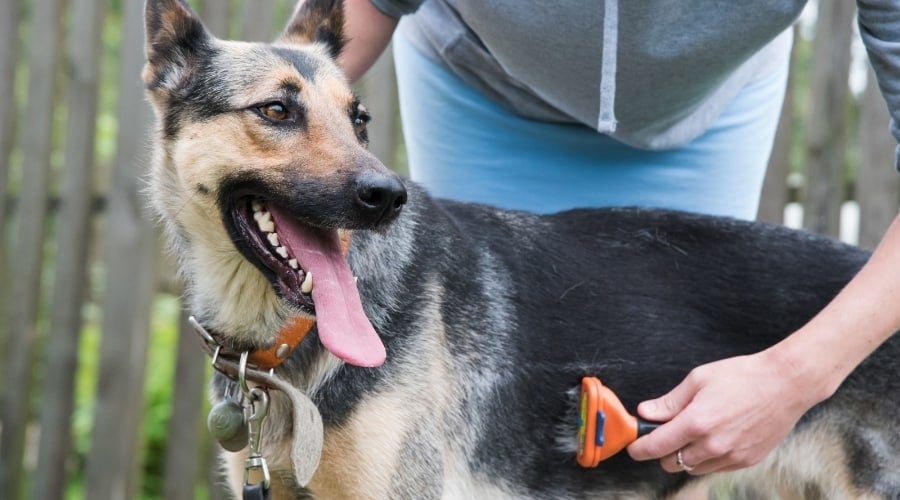
German Shepherds shed equally year-round but will shed more in the winter and summer months. They are a double-coated dog breed, which means they have two layers of dog fur. Their top-coat protects against the elements, including water, ice, and wind. Their shorter underlayer helps keep them warm. It also means they will shed a lot and need regular grooming.
Because this is a double-coated breed, they will “blow” their coat twice per year. This is slang for when a dog sheds their outer coat in the summer to keep cool, and again in the wintertime to allow a new undercoat to come in to protect from the cold. During this time, dog fur will be everywhere. We’d recommend grooming your pup every day and using a deshedder, especially in the summertime.
Shedding Triggers
Like any dog breed, there are also things that can happen in your pup’s life that will cause them to shed more than normal. German Shepherds are particularly notorious for being anxious when something in their life isn’t right. Below are some of the most common themes you’ll need to consider if you notice your dog is shedding more than normal.
Stress: This is a more anxious dog breed due to their active nature. When they get stressed out, this additional stress can trigger hormones in their body, resulting in the loss of additional dog fur.
New Additions: Falling under the stress category, if you’ve recently had a new addition that’s upset the balance of harmony in your home, this could be the cause for excess shedding. This could be anything from a new baby, to a new puppy or cat that you’ve introduced.
Hormone Changes: If your pup recently became pregnant, or has had other hormone changes in their body, fur loss can also be a common temporary symptom.
Allergies: This breed is also known for having sensitive skin. If they have an allergic reaction to something in your yard, it’s not uncommon for their skin to flare up, which may cause hair loss.
Mites & Fleas: If your pup has mites or fleas, a common side effect is fur loss. This usually impacts their skin underneath the fur, so fur loss is more of a by-product.
Nutrition: Changes in diet can impact your dog’s coat, and any allergic reaction to a new food can cause hair loss. Ensure you feed your dog a dry kibble that’s high in Omega 3 and 6 fatty acids to promote coat health and longevity.
These are the most common reasons for fur loss in German Shepherds. As always, we recommend consulting with a veterinarian if your dog starts to exhibit fur loss without any easy to identify reasons behind it.
Managing Their Fur
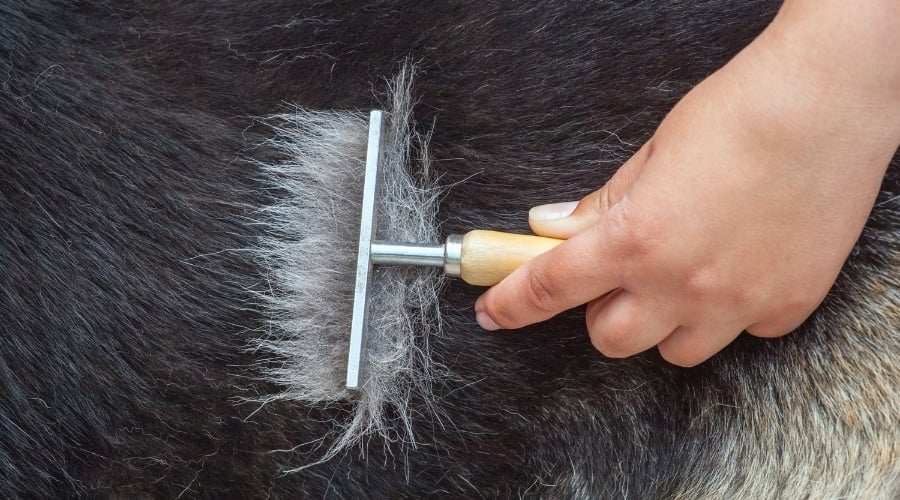
The good news is that even though German Shepherds shed, it’s fairly easy to manage. There are some simple steps you can take on a daily, weekly, and monthly basis to ensure that their fur is less likely to be left around your home, on your furniture, or on your clothing.
Brushing
Brushing should be a minimum of a three times per week occurrence with your German Shepherd, regardless of their coat length. If your pup has a longer coat, you’ll want to keep up with brushing on a daily basis. Brush with a pin brush for the best result. Most regular brushes won’t get all the loose fur out of your pup’s coat in one sitting. A longer pin brush is perfect for this task.
Deshedding Products
Deshedding tools are a must for the German Shepherd. They are best used during the coat blowing season, in winter and summer. These tools are safe to use on your dog’s coat, all over their body. They are also great to use underneath your pup, to remove excess fur from under their belly. We’d recommend looking at a tool like the Furminator for the best results. They aren’t too expensive, and your regular weekly brushing will be much easier.
Bathing
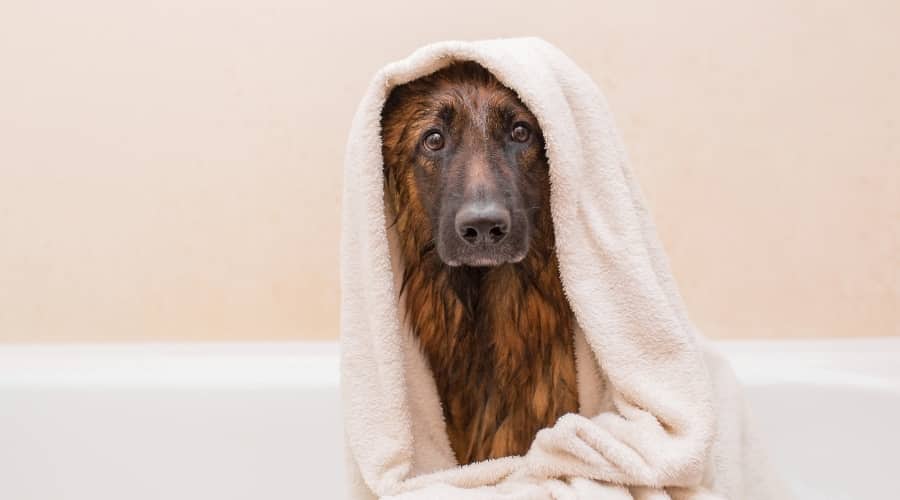
German Shepherds have sensitive skin. This can make bathing more of a challenge because you don’t want to dry out their skin. Sensitive skin means you can’t use any shampoo of your choosing. We actually don’t recommend using an anti-shed shampoo for any dogs with extremely sensitive skin.
For dogs with sensitive skin, we recommend using an oatmeal shampoo, or a dog shampoo that has natural ingredients. Anything else is likely to cause skin irritation, which will then cause additional shedding. This essentially works against you, backfiring in trying to control your dog’s shedding by causing more fur loss.
Diet
When it comes to your dog’s coat health, don’t neglect nutrition. Many dog owners don’t realize, that allowing your pup to eat low-quality dog food can impact their coat health. German Shepherds should consume high-quality dry kibbles that are rich in Omega fatty acids to promote skin and coat health. There are several different brands and food formulas that can meet your dog’s needs. The bottom line is this: Don’t sleep on nutrition when it comes to coat health.
Supplements
Supplements can be great to help your dog improve their skin and coat health. Taking Omega fatty acid chewable or liquid supplements will ensure your pup’s coat is both shiny and healthy. But it’s not usually a need unless your dog isn’t on a diet that already contains adequate amounts of these nutrients. If you are already feeding your pup a high-quality kibble, these types of supplements will be purely optional.
Frequently Asked Questions
Still can’t figure out why your German Shepherd may be shedding more than normal? Below are some commonly asked questions that we’ve compiled for you if you still haven’t found your answer.
Why is my German Shepherd shedding so much?
As mentioned above, there could be several reasons. But the number one reason for increased shedding happens to be stress or a break in your dog’s normal routine. There is no reason to get anxious if you’ve recently moved houses, changed a work schedule, or added a new dog to your home. If something seems out of place though, such as changes in behavior, consult with your vet.
Will they shed more in the summer and winter?
Yes, your dog will shed more in both the summer and the winter. They are double-coated dogs, which means you’ll need to spend more time grooming during these times of the year.
When do they shed their puppy coat?
Typically most dogs shed their “puppy coat” at around six months of age. This is when their adult fur comes in, which can be slightly coarser, and longer.
How can I make my German Shepherd shed less?
If you do as we’ve advised, and stick to a regular grooming routine, your pup should shed less, making living indoors with a double-coated breed more manageable.
Do Black, White, or Blue German Shepherds shed less?
As mentioned above, the color of your dog’s fur will not impact their shedding frequency. A Black coated pup is just as likely to shed as one with a Black and Tan coat.
Do Males or Females shed more?
Females can shed more when their hormones change, usually when they are pregnant or are in heat. Outside of that, there’s no difference in shedding volume and frequency, when comparing male to female.
Are there some German Shepherd mixes that don’t shed?
Almost all German Shepherd crossbreeds will shed. The Shepadoodle is one that is likely to shed less though, as a result of having a Poodle parent. While not considered hypoallergenic, the Shepadoodle is your closest shot at a “non-shedding” German Shepherd crossbreed.
Final Thoughts
Bottom Line: German Shepherds do shed, and quite a bit. But that’s not a reason to avoid adopting one of these magnificent canines. If you stick to a regular bathing and grooming schedule, there’s no reason at all you shouldn’t be able to welcome one into your home. If fur management isn’t something you truly want to mess with, we’d recommend sticking to a Hypoallergenic dog breed that might make dog ownership easier for you and your family.

